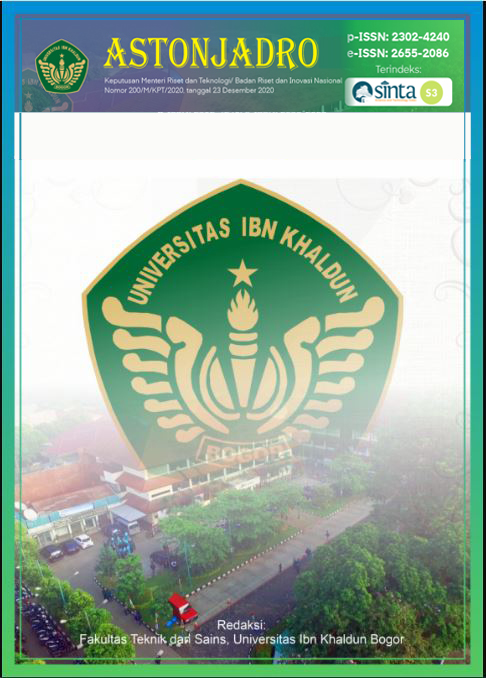Choosing Commuter Transportation Modes to Support Human Mobility (Case Study: Bulukumba Regency, South Sulawesi)
DOI:
https://doi.org/10.32832/astonjadro.v11i3.7492Keywords:
modes, commuter, transportation, motorbikes, easy access.Abstract
To carry out daily activities and fulfill needs requires movement. In carrying out these movement, there are two choice, namely moving with transportation modes or without transportation modes (walking). This study aims to knowing the factors that influence the choice of private and public transportation modes as well as modeling the choice of commuter transportation modes. Focus of this study is Bulukumba regency that one of the regencies in the southern part of South Sulawesi. The transportation characteristics discussed are the characteristics of the trip (the purpose of he trip, time and distance), characteristics of behaviour travellers (mode selection and reasons for choosing the mode) and characteristics of transportation facilities (Quantitatively involves: waiting time, time for access to other modes and tariffs. Qualitatively involves: safety, comfort and trust). The result of the analysis obtained information that the dominant mode of transportation is used by commuter in Bulukumba regency are private motor vehicles. The tendency of the people of Bulukumba regency to use motorbikes is assessed because motorbikes have a high level of comfort and trust, cheap tariff, flexible schedule, easy access, quickly reach travel destinations and efficiency in use compared to private cars or public transportation modes. The R2 value of the private motorbike mode selection model is 0.765 meaning that the education and work variables affect the motorbike mode selection by 76.5% and the rest is influenced by other variables. The model for selection public transportation modes has an R2 value of 0.666, meaning that the tourism and trade variables affect the choice of the public transportation modes by 66.6% and the rest is influenced by other variables.
References
Adisasmita, R. Analisis Kebutuhan Transportasi. Graha Ilmu. Yogyakarta. (2015). ISBN, 978–602–262–394–6.
Adisasmita, S. Transportasi dan Pengembangan Wilayah. (2011). Yogyakarta: Graha Ilmu.
Bakri, J. Transportasi Multimoda (Sebuah Pemodelan Kebutuhan Transportasi Multimoda. (2016). Intimedia Jatim. ISBN, 978–6021507–51–3.
Hidayat, D. Panduan lengkap menguasai SPSS 19 Untuk Mengolah Data Statistik Penelitian. (2011). ISBN, 979–794–312–7.
Irjayanti, dkk. Perilaku Pemilihan Moda Transportasi Pekerja Komuter: Studi Kasus Jabodetabek. (2021). Jurnal Ekonomi dan Pembangunan Indonesia, 21(2), 2406–9280.
Kawengian. Model Pemilihan Moda Transportasi Angkutan Dalam Provinsi. (2017). In Jurnal Sipil Statik Vol.5 No.3. ISSN (hal. 2337–6732).
Miro, F. Perencanaan Transportasi. (2008). Jakarta: Erlangga
Miro, F. Pengantar Sistem Transportasi. (2012). Penerbit Erlangga. ISBN.
Mulyono, S. Teori Pengambilan Keputusan. (1996). Jakarta: Lembaga Penerbitan LPFE-UI.
Sani, Z. Transportasi (Suatu Pengantar). Penerbit UI. (2010).
Sijabat. Model Pemilihan Moda Pergerakan Komuter Di Kecamatan Sayung. (2013). In JurnalTeknikPWK (Vol. 2, hal. 4).
Somantri, dkk. Aplikasi Statistika Dalam Penelitian (C. V. P. S. Bandung (ed.)). (2014).
Tamin, O. Z. Perencanaan Pemodelan dan Rekayasa Transportasi, Teori, contoh soal dan aplikasi. (2008). Penerbit Institut Teknologi Bandung.
Vuchic, V.R. Urban Public Transportation Systems and Technology. (1981). New Jersey: Prentice - Hall. Inc.
Wulansari, I. Literature Review Galat Dalam Pemodelan dan Peramalan (2021). Jurnal Citizen Vol 1 No 3. ISSN:2807-5994
Downloads
Published
How to Cite
Issue
Section
License
Copyright (c) 2022 ASTONJADRO: CEAESJ

This work is licensed under a Creative Commons Attribution-ShareAlike 4.0 International License.
Paper submitted to ASTONJADRO is the sole property of the Astonjadro Journal. Unless the author withdraws the paper because he does not want to be published in this journal. The publication rights are in the journal Astonjadro.ASTONJADRO
LICENSE
This work is licensed under a Creative Commons Attribution-ShareAlike 4.0 International License.
Based on a work at http://ejournal.uika-bogor.ac.id/index.php/ASTONJADRO













